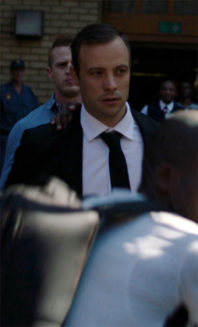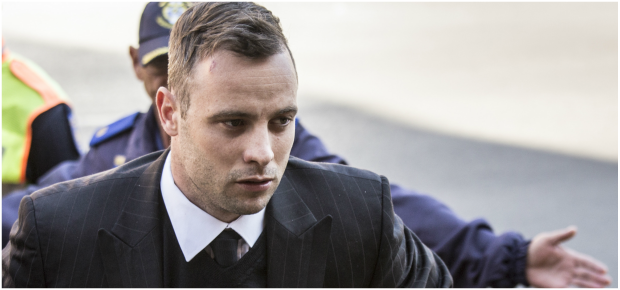
In recent years, perhaps no other person has seen as dramatic a rise to stardom and then subsequent fall from grace as Oscar Pistorius. In the span of just one year, he was vaulted to international fame by becoming the first double-leg amputee to compete in the Olympic Games and then just as suddenly saw everything come crashing down when he shot and killed his girlfriend, South African model Reeva Steenkamp, in his home. The world’s attention quickly shifted from feel-good admiration to morbid fascination and now Pistorius’s name amounts to nothing more than a sick punchline (see the recent “Blade Gunner” Halloween costumes on sale where you can dress up as an athletically clad Pistorius holding a gun).
But as with any story of this magnitude, there is much more to it than what was initially reported. Now, with five years distance from that fateful night in a gated community in Pretoria (and with the latest appeal to overturn Pistorius’s current 13-year murder sentence recently denied), director Vaughan Sivell’s new docuseries, currently streaming on Amazon Prime, aims to take a fresh look at the crime and get a clearer picture of who the enigmatic Pistorius really was. Split into four hour-long episodes, Sivell also takes cues from the recent success of O.J.: Made in America in examining how the Pistorius saga became a lightning rod for the entire social state of a country in tumultuous transition.
In episode one, Sivell starts right at the beginning of Pistorius’s life. Born with a congenital absence of the fibula and having both legs amputated below the knee at 11 months, Pistorius still engaged in an active childhood, taking an early interest in athletics and rejecting the idea that his disability put him at any sort of disadvantage. While his home life was a little more tumultuous, having an absent father and dealing with his mother’s death when he was 15, Pistorius still managed to attend the prestigious Pretoria Boys High School, thanks to a wealthy uncle, and quickly excelled socially and athletically.
At the same time, South Africa was in a state of serious flux, with the end of apartheid kicking off an era of uncertainty and heated racial tensions between liberated black South Africans and their former white oppressors. In this new democratic system, there was real opportunity for change and equality, yet the engrained societal norms also weren’t so easily shaken off. By that token, despite Pistorius’s personal challenges, he was still part of a white elite class, shielded from the everyday violence and poverty that seemed to be a natural part of South African life.
Running through Pistorius’s accomplishments on the track, it’s hard not to be impressed by the sheer will and determination of this man to be the best. Winning medal after medal in Paralympic championships, it’s easy to see why major athletic sponsors flocked to him and why the sports media fawned. Dubbed the “Blade Runner”, Pistorius was the next evolution in athletics, with sci-fi themed ads that illuminated a competitor who refused to let anything stand in the way of his goals.
As the most visible face in the Paralympic community, there’s no denying how much of an icon he was to disabled people everywhere. But more than that, he became a symbol for South Africa, someone who the entire country could rally around regardless of race or social class, in much the same way as the Springboks did during the 1995 Rugby World Cup.
And then just as Pistorius’s celebrity was at its peak, it all took such a dark turn in the early hours of Valentine’s Day 2013. The subsequent three episodes of the series delve into the crime and subsequent trial and media circus that erupted around it. The events may have just been a salacious blip in world news coverage to North American audiences, but in South Africa it was as much a national obsession as the O.J. trial, with exhaustive media coverage and even a full network devoted to dissecting every bit of minutiae to come out of it.
Of course, this led to a ton of misinformation and rumours being reported as fact, until the entire ordeal became a smorgasbord of uncertainty. The trial also became a crucial test case for how a privileged white South African man was going to be treated on the stand, especially since the judge in the case was the esteemed Thokozile Masipa, one of the only black women to be appointed to the High Court of South Africa, presenting an interesting role reversal of the norm. Was this going to be a case of domestic violence and woman abuse, which was at all-time highs in the country, or, if Pistorius and his legal team were to be believed, was it a case of social and class crime in South Africa, where violent burglaries in wealthy neighbourhoods are an everyday reality?
Fans of true crime docuseries will be familiar with the techniques Sivell employs, from grisly crime scene photos to plentiful courtroom footage to recorded private text and e-mail conversations, to get at the truth. As he reveals more of the actual evidence from the crime that got lost in the immediate aftermath, the picture of what actually happened becomes cloudier and cloudier. And unlike O.J., who had clear warning signs and previous domestic violence incidents leading up to the murder of his wife, this incident seemingly came out of nowhere, with Pistorius and Steenkamp only having been together for a few months. To make matters more complex, both the prosecution’s and defense’s accounts of the events of that night more or less line-up with the timeline of evidence, making it increasingly hard to secure a guilty verdict.
Sivell gains extensive interviews with almost everyone who was intricately involved (with the exception of Pistorius himself), all of who place the story in a new context or twist things in a new direction. Pistorius’s family is all still behind him and come off earnestly enough until details emerge about certain members involved in evidence tampering. Lead reporters from all different backgrounds who covered the trial at the time, each give their own accounts of the social climate and what they took away from it all. Jacqui Mofokeng, the leader of the ANC Women’s League, led the charge to appeal the initial culpable homicide verdict and presents some of the strongest arguments for the domestic violence angle through her interviews. But then it’s revealed that the Women’s League rarely showed up for any other rape cases against black women in the country and even campaigned for former President Jacob Zuma during his rape trial, while actively discrediting the women who accused him. When confronted with this, Mofokeng has no response. Sivell does what any good documentarian should, presenting all different sides and leaving it to us to figure out where we stand.
By the end of it all, watching Pistorius squirm and flail hysterically in court when he finally takes the stand is enough to believe the most obvious conclusion that he murdered Steenkamp in a sudden fit of rage. Through all the interviews and extensive archival footage, Sivell paints a portrait of an insecure man, prone to petulance and forever haunted by the idea that he might not be good enough, despite his outward appearances to the contrary. Underneath the benign smiles and go-getter positivity, there was a ticking time bomb set to go off, further enhanced by a cultural atmosphere of fear, violence and paranoia.
If we’re still left with questions at the end, it’s only because the series excels at uncovering every last connected detail. Only Pistorius himself knows what actually went on that night at his home. And as one interviewee remarks toward the end of the series, even he might not fully know anymore.
- Release Date: 9/6/2018



